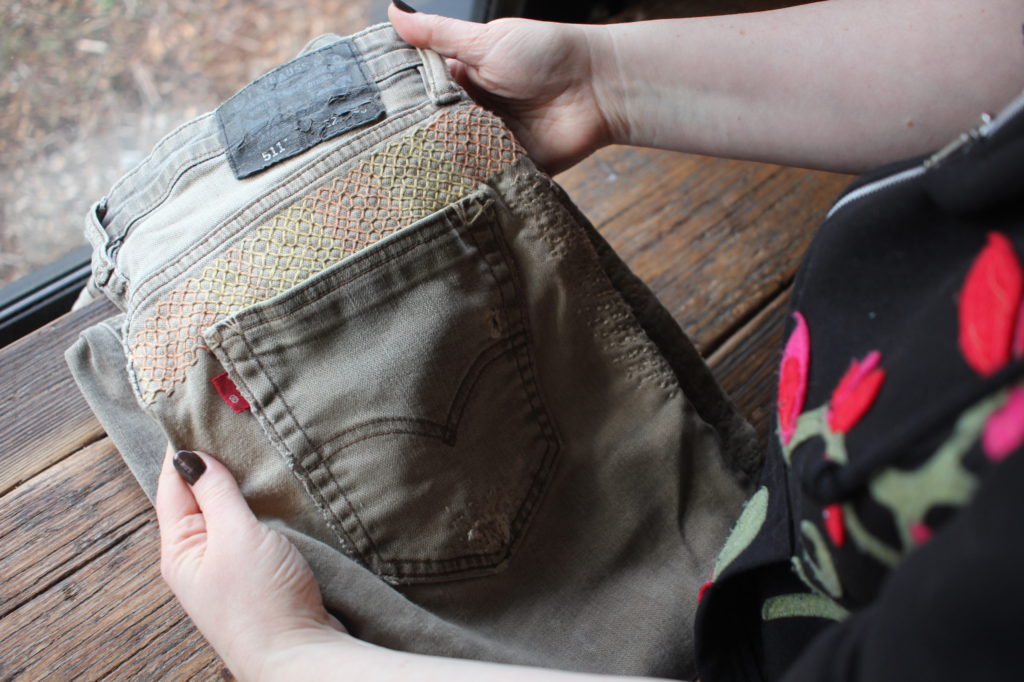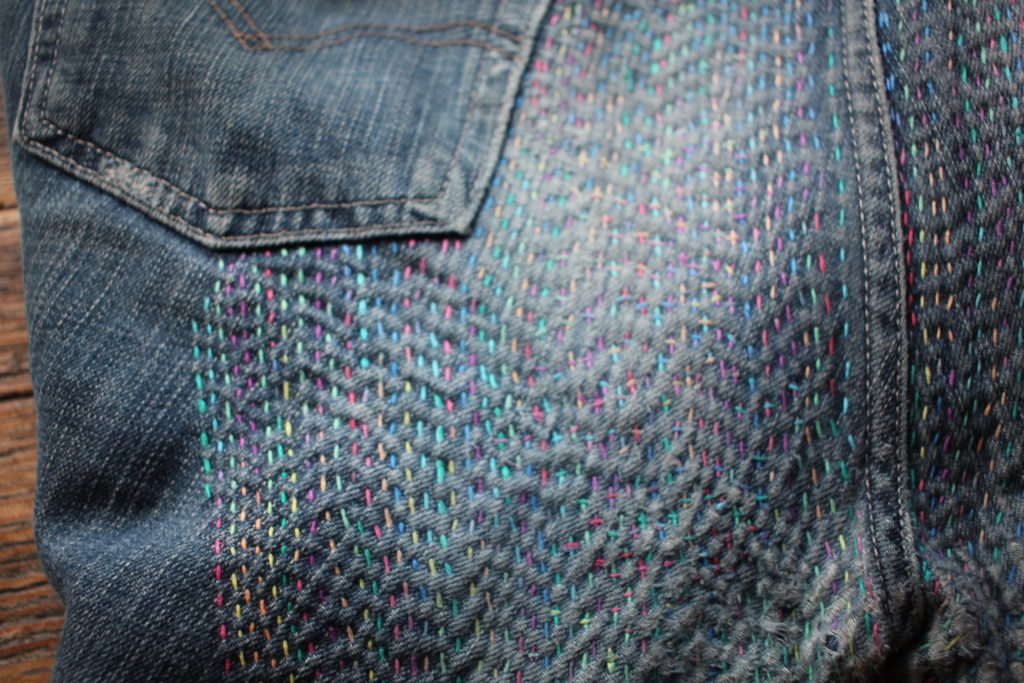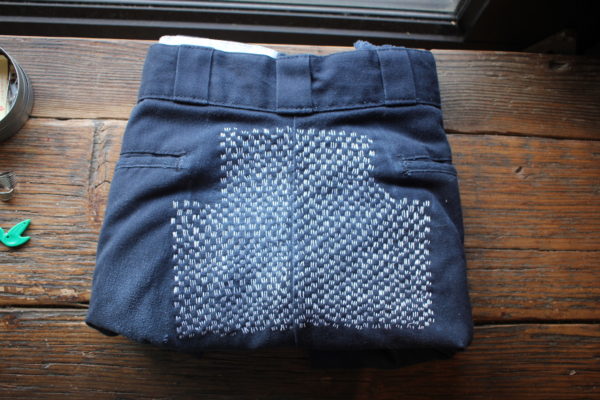A year and a half ago, Kyndall Nelson was a stay-at-home mom and artist, whose main creative outlet was painting.
“I had to kind of segregate myself to sit and paint,” Nelson recalled. “My back was to everyone, my kids were running around, I couldn’t really interact… I never felt like I could give painting the time that I wanted to. I wanted to have something artistic to do that is mine, but didn’t want to have to close off from the rest of my life to do it.”
Then, in January of 2019, Nelson’s favorite jeans ripped out in the groin (as favorite jeans are wont to do) and she turned to the internet to purchase a new pair. There she learned another tragically common favorite-jeans fact: that particular pair of pants no longer existed.
“So I started asking around for where I might be able to get them fixed,” Nelson said. A friend recommended she check out @rhomatt, an Instagram account documenting the work of a Virginia-based denim repairer. His profile bio offers a link to his own detailed, informative how-to article about how to get started with boro mending, the style of repair he performs, which utilizes visible patches and sashiko stitching.
According to Nelson, she instantly “fell in love with the art and ran with it.” She promptly undertook a boro-style repair on her own busted jeans, consumed everything she could learn about the method on Instagram and Wikipedia, and started asking around for repair work on her neighborhood’s Buy Nothing Facebook group, offering free fixes as a means to learning. Now, she documents her repair work on her Instagram page (@KnarlyKnart).
From early on, Nelson says, it wasn’t unusual for her to put in 8-10 hours of hand-mending work a day. Since then, she’s had to find a balance, and estimates her total daily sewing time is closer to 4-5 hours, these days.
“Everywhere that I will be sitting, I bring it,” Nelson said. “It’s much easier to have a lap project [than to paint]. I can talk and interact, I can put it aside and get up to help. It really fits into my life a lot better.
“And I never felt as obsessed with painting as I do with this,” she added. 
Boro is a traditionally Japanese art of textile mending. The word “boro” translates literally to “rags” or “scraps,” and is also used as shorthand for clothing or household items that have been mended many times over, accumulating layers of patches. Boro patches are affixed with sashiko stitching – a style of decorative reinforcement embroidery built of small running stitches, often intricately patterned.
Nelson refers to her own mending style as “sashiko-inspired,” acknowledging that she doesn’t follow the tradition to the letter. She loves to use bright thread colors and play around with pattern designs. When she receives a mending project from a person, she tries to assess their personality and factor that into her planned repair.
“I try to figure out, ‘is this a chaos or order person, are you a subtle or bright,’ and get an idea of what style of patch would suit them,” Nelson said. “And if I know the person, I like to see if they’re ok with me just running with it.”
Of course, her repair clients are encouraged to specify details that are important to them: “My main questions I ask are if they want the patch to stand out or blend in, and if they have a preferred thread color.”
Whenever possible, Nelson prefers to barter for her repair work. On a pair of jeans belonging to the owner of a local feed n’ seed store, Nelson wagers she’s put in more than 75 hours of repair work over the course of multiple repairs.
“So instead of paying cash, we just worked out a deal where I call her when I need chicken supplies, and I get chicken supplies,” Nelson said.
“I’m happy to do business that way, because I want everyone to have the things that they love without it having to be a monetary exchange. The barter system is truly so good.”
Embroidery, hand stitching, and other repetitive-motion crafts (like sewing and knitting) have long been touted for their inherent psychological benefits. They reputedly lower blood pressure and induce a sense of calm and accomplishment. Sashiko stitching, which is fundamentally time-consuming, is a strong candidate for “calming quarantine hobby” for those who are still in the market for something to take up large portions of newly at-home days. Like Nelson found, Instagram is a great place to start, with plenty of how-to freebies from great accounts to get you started.
Consider checking if your regular craft and fabric stores are open for pick-up business and stocked with sashiko supplies, or scrounge around the house – this art’s tools are fortunately humble and common enough that you might have the necessary supplies tucked away without even realizing it.
If hand-mending your clothes yourself is a heftier craft than you’re up to this quarantine, good news: Nelson is still accepting drop-off repairs. After making contact through her Instagram page and chatting about the desired repair, she asks that clients drop their denim on her porch in a bag with their name on it. She will then wash the jeans in cold water on a delicate cycle and air dry before working on them. When the jeans are ready, she and the client set a time for her to set out the denim on her porch for pickup.
If they’re paying in cash, Nelson says, Venmo or other contactless service is great. And if people refer to work out a barter, like so much else in our lives right now, Nelson says “we’ll figure that out as we go.”
